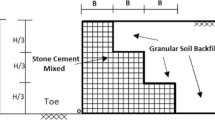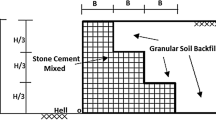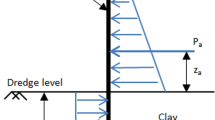Abstract
The stability of retaining walls against overturning is analyzed in this study using artificial intelligence methods. Five input parameters including wall height, wall thickness, soil friction angle, soil density, and stone cement mixture density were varied and 2000 cases were considered in developing the predictive models. Using the artificial neural network (ANN) method, eight prediction models were developed and evaluated based on the coefficient of determination (R2) and the root mean square error. R2 values of 0.9740 and 0.9824 for training and testing datasets, respectively (for the best model), indicate the level of ANN capability in predicting safety factor (SF) of retaining walls. After developing the ANN model, the ant colony optimization (ACO) algorithm was used to maximize the safety factor of the wall by varying the input parameters. In fact, the best ANN model was selected to be used as a modeling function in ACO algorithm. The SF result from optimization section was obtained as 3.057 which show a significant difference from the mean SF values used in the modeling. It can be concluded that ACO may be used as a powerful optimization algorithm in optimizing SF results of retaining walls.













Similar content being viewed by others
References
Coulomb CA (1776) “Essai sur une Application des Règles de Maximis et Minimis à Quelques Problèmes de Statique Relatifs à L’Architecture,” Mèmoires de la Mathèmatique et de Phisique, présentés à l’Académie Royale des Sciences, par divers savans, et lûs dans sés Assemblées. Annee 1793:343–382
Rankine WJM (1857) On the mathematical theory of the stability of earthwork and masonry. J Franklin Inst 63:84–85
Terzaghi K (1943) Theoretical soil mechanics. Wiley, New York
Yu G-Y, Bai Y-S, Sheng P, Guo R-P (2009) Mechanical performance of a double-face reinforced retaining wall in an area disturbed by mining. Min Sci Technol 19:36–39
Chan YC (1996) Study of old masonry retaining walls in Hong Kong. Geotechnical Engineering Office, Civil Engineering Department, Hong Kong
Rankine WJM (1857) On the stability of loose earth. Philos Trans R Soc Lond 1:9–27
Tsagareli ZV (1965) Experimental investigation of the pressure of a loose medium on retaining walls with a vertical back face and horizontal backfill surface. Soil Mech Found Eng 2:197–200
Chang M-F (1997) Lateral earth pressures behind rotating walls. Can Geotech J 34:498–509
O’Neal TS, Hagerty DJ (2011) Earth pressures in confined cohesionless backfill against tall rigid walls—a case history. Can Geotech J 48:1188–1197
Iskander M, Chen Z, Omidvar M et al (2013) Active static and seismic earth pressure for c–ϕ soils. Soils Found 53:639–652
Gordan B, Koopialipoor M, Clementking A et al (2018) Estimating and optimizing safety factors of retaining wall through neural network and bee colony techniques. Eng Comput. https://doi.org/10.1007/s00366-018-0642-2
Faradonbeh RS, Armaghani DJ, Majid MZA et al (2016) Prediction of ground vibration due to quarry blasting based on gene expression programming: a new model for peak particle velocity prediction. Int J Environ Sci Technol 13:1453–1464
Koopialipoor M, Armaghani DJ, Haghighi M, Ghaleini EN (2017) A neuro-genetic predictive model to approximate overbreak induced by drilling and blasting operation in tunnels. Bull Eng Geol Environ. https://doi.org/10.1007/s10064-017-1116-2
Ebrahimi E, Monjezi M, Khalesi MR, Armaghani DJ (2016) Prediction and optimization of back-break and rock fragmentation using an artificial neural network and a bee colony algorithm. Bull Eng Geol Environ 75:27–36
Ghaleini EN, Koopialipoor M, Momenzadeh M et al (2018) A combination of artificial bee colony and neural network for approximating the safety factor of retaining walls. Eng Comput. https://doi.org/10.1007/s00366-018-0625-3
Mohamad ET, Faradonbeh RS, Armaghani DJ et al (2017) An optimized ANN model based on genetic algorithm for predicting ripping production. Neural Comput Appl 28(Suppl 1):393. https://doi.org/10.1007/s00521-016-2359-8
Khandelwal M, Armaghani DJ (2016) Prediction of drillability of rocks with strength properties using a hybrid GA-ANN technique. Geotech Geol Eng 34:605–620. https://doi.org/10.1007/s10706-015-9970-9
Jahed Armaghani D, Mohd Amin MF, Yagiz S et al (2016) Prediction of the uniaxial compressive strength of sandstone using various modeling techniques. Int J Rock Mech Min Sci 85:174–186. https://doi.org/10.1016/j.ijrmms.2016.03.018
Safa M, Shariati M, Ibrahim Z et al (2016) Potential of adaptive neuro fuzzy inference system for evaluating the factors affecting steel-concrete composite beam’s shear strength. Steel Compos Struct 21:679–688
Mohammadhassani M, Nezamabadi-Pour H, Suhatril M, Shariati M (2013) Identification of a suitable ANN architecture in predicting strain in tie section of concrete deep beams. Struct Eng Mech 46:853–868
Moayedi H, Rezaei A (2017) An artificial neural network approach for under-reamed piles subjected to uplift forces in dry sand. Neural Comput Appl. https://doi.org/10.1007/s00521-017-2990-z
Moayedi H, Jahed Armaghani D (2017) Optimizing an ANN model with ICA for estimating bearing capacity of driven pile in cohesionless soil. Eng Comput. https://doi.org/10.1007/s00366-017-0545-7
Hasanipanah M, Jahed Armaghani D, Bakhshandeh Amnieh H et al (2016) Application of PSO to develop a powerful equation for prediction of flyrock due to blasting. Neural Comput Appl. https://doi.org/10.1007/s00521-016-2434-1
Hasanipanah M, Monjezi M, Shahnazar A et al (2015) Feasibility of indirect determination of blast induced ground vibration based on support vector machine. Measurement 75:289–297
Hasanipanah M, Shahnazar A, Amnieh H (2017) Prediction of air-overpressure caused by mine blasting using a new hybrid PSO–SVR model. Eng Comput. https://doi.org/10.1007/s00366-016-0453-2
Hasanipanah M, Amnieh HB, Khamesi H et al (2018) Prediction of an environmental issue of mine blasting: an imperialistic competitive algorithm-based fuzzy system. Int J Environ Sci Technol 15:551–560
Khandelwal M, Singh TN (2009) Prediction of blast-induced ground vibration using artificial neural network. Int J Rock Mech Min Sci 46:1214–1222
Gandomi AH, Kashani AR, Roke DA, Mousavi M (2017) Optimization of retaining wall design using evolutionary algorithms. Struct Multidiscip Optim 55:809–825
Saghatforoush A, Monjezi M, Faradonbeh RS, Armaghani DJ (2016) Combination of neural network and ant colony optimization algorithms for prediction and optimization of flyrock and back-break induced by blasting. Eng Comput 32:255–266
Dorigo M, Maniezzo V, Colorni A (1996) Ant system: optimization by a colony of cooperating agents. IEEE Trans Syst Man Cybern Part B 26:29–41
Dorigo M, Gambardella LM (1997) Ant colonies for the travelling salesman problem. Biosystems 43:73–81
Dorigo M, Gambardella LM (1997) Ant colony system: a cooperative learning approach to the traveling salesman problem. IEEE Trans Evol Comput 1:53–66
Bullnheimer B, Hartl RF, Strauss C (1999) Applying the ant system to the vehicle routing problem. In: Meta-heuristics. Springer, Berlin, pp 285–296
Zhang J, Hu X, Tan X et al (2006) Implementation of an ant colony optimization technique for job shop scheduling problem. Trans Inst Meas Control 28:93–108
Mazzeo S, Loiseau I (2004) An ant colony algorithm for the capacitated vehicle routing. Electron Notes Discrete Math 18:181–186
Dréo J, Siarry P (2004) Continuous interacting ant colony algorithm based on dense heterarchy. Futur Gener Comput Syst 20:841–856
Kong M, Tian P (2006) Application of ACO in continuous domain. In: International conference on natural computation. Springer, Berlin, pp 126–135
Shishvan MS, Sattarvand J (2015) Long term production planning of open pit mines by ant colony optimization. Eur J Oper Res 240:825–836
Zhu J, Xiao-ping M (2009) Safety evaluation of human accidents in coal mine based on ant colony optimization and SVM. Procedia Earth Planet Sci 1:1418–1424
Gao W (2015) Forecasting of rockbursts in deep underground engineering based on abstraction ant colony clustering algorithm. Nat Hazards 76:1625–1649
Peck RB, Hanson WE, Thornburn TH (1974) Foundation engineering. Wiley, New York
McCulloch WS, Pitts W (1943) A logical calculus of the ideas immanent in nervous activity. Bull Math Biophys 5:115–133
Priddy KL, Keller PE (2005) Artificial neural networks: an introduction. SPIE Press, Bellingham
Koopialipoor M, Armaghani DJ, Hedayat A et al (2018) Applying various hybrid intelligent systems to evaluate and predict slope stability under static and dynamic conditions. Soft Comput. https://doi.org/10.1007/s00500-018-3253-3
Koopialipoor M, Fallah A, Armaghani DJ et al (2018) Three hybrid intelligent models in estimating flyrock distance resulting from blasting. Eng Comput. https://doi.org/10.1007/s00366-018-0596-4
Garrett JH (1994) Where and why artificial neural networks are applicable in civil engineering. J Comput Civ Eng 8:129–130
Haykin S, Network N (2004) A comprehensive foundation. Neural Netw 2:41
Koopialipoor M, Nikouei SS, Marto A et al (2018) Predicting tunnel boring machine performance through a new model based on the group method of data handling. Bull Eng Geol Environ. https://doi.org/10.1007/s10064-018-1349-8
Hasanipanah M, Armaghani DJ, Amnieh HB et al A Risk-Based Technique to Analyze Flyrock Results Through Rock Engineering System. Geotech Geol Eng 1–14
Jahed Armaghani D, Hajihassani M, Monjezi M et al (2015) Application of two intelligent systems in predicting environmental impacts of quarry blasting. Arab J Geosci 8:9647–9665. https://doi.org/10.1007/s12517-015-1908-2
Fausett L, Fausett L (1994) Fundamentals of neural networks: architectures, algorithms, and applications. Prentice-Hall, Englewood Cliffs
Hornik K, Stinchcombe M, White H (1989) Multilayer feedforward networks are universal approximators. Neural Netw 2:359–366
Koopialipoor M, Ghaleini EN, Haghighi M et al (2018) Overbreak prediction and optimization in tunnel using neural network and bee colony techniques. Eng Comput. https://doi.org/10.1007/s00366-018-0658-7
Zorlu K, Gokceoglu C, Ocakoglu F et al (2008) Prediction of uniaxial compressive strength of sandstones using petrography-based models. Eng Geol 96:141–158
Dorigo M (1992) Optimization, learning and natural algorithms. Ph.D. Thesis, Politec di Milano
Hajizadeh Y, Christie M, Demyanov V (2011) Ant colony optimization for history matching and uncertainty quantification of reservoir models. J Pet Sci Eng 77:78–92
Socha K, Dorigo M (2008) Ant colony optimization for continuous domains. Eur J Oper Res 185:1155–1173
Janacik P, Orfanus D, Wilke A (2013) A survey of ant colony optimization-based approaches to routing in computer networks. In: 2013 4th International conference on intelligent systems modelling and simulation (ISMS). IEEE, pp 427–432
Author information
Authors and Affiliations
Corresponding authors
Ethics declarations
Conflict of interest
The authors declare no conflict of interest.
Additional information
Publisher’s Note
Springer Nature remains neutral with regard to jurisdictional claims in published maps and institutional affiliations.
Rights and permissions
About this article
Cite this article
Koopialipoor, M., Murlidhar, B.R., Hedayat, A. et al. The use of new intelligent techniques in designing retaining walls. Engineering with Computers 36, 283–294 (2020). https://doi.org/10.1007/s00366-018-00700-1
Received:
Accepted:
Published:
Issue Date:
DOI: https://doi.org/10.1007/s00366-018-00700-1




